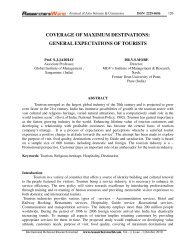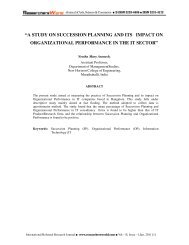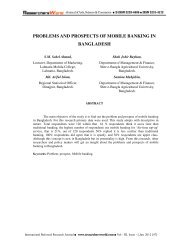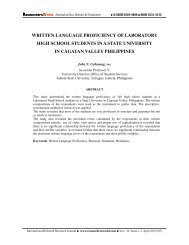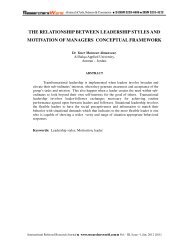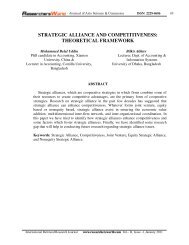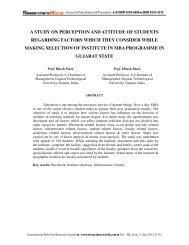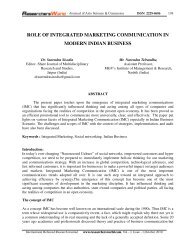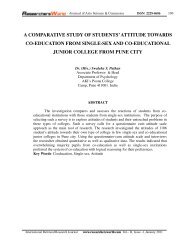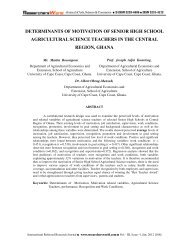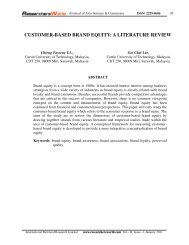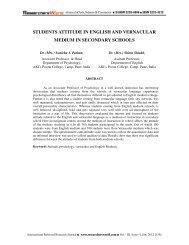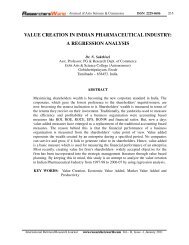settlement patterns and economic development - Researchers World
settlement patterns and economic development - Researchers World
settlement patterns and economic development - Researchers World
Create successful ePaper yourself
Turn your PDF publications into a flip-book with our unique Google optimized e-Paper software.
RESULTS AND DISCUSSION:<br />
-Journal of Arts, Science & Commerce ■ E-ISSN 2229-4686 ■ ISSN 2231-4172<br />
The data collected allowed us to discuss the results under four main headings:<br />
Demographic information on respondents<br />
Trend of <strong>development</strong><br />
Values of people<br />
Causes of lack of <strong>development</strong><br />
DEMOGRAPHIC INFORMATION OF THE RESPONDENTS:<br />
In this section, we provide information on the age <strong>and</strong> gender (Table 1) <strong>and</strong> occupational mix<br />
of the different communities (Table 2). The sample was made up of 77 men <strong>and</strong> 31 women. For the<br />
three different <strong>settlement</strong> groups, the modal age group is the 41-50 year group; 12 for the indigene<br />
group, 15 for the settler, <strong>and</strong> 12 for the mixed communities. Thus, of the 108 respondents 39 (27%)<br />
are in the 41-50 year category, while the 61-70 age group make up only 12% (14) of the population. It<br />
is important to note, however, that the number is highest in the indigene communities than in either<br />
the mixed or the settler communities. This could also be explained by the fact that many of the<br />
settlers go back to their original towns as they age.<br />
OCCUPATIONAL MIX:<br />
Of the 20 people in the indigene group who responded to the question on occupation, only<br />
seven (35%) indicated that they were full time farmers. The others were involved in other trades as<br />
seen in Table 2. Many of the respondents, however, indicated that though they were not farmers, they<br />
had farm l<strong>and</strong>s. This means they hired labourers to work on their farms. Of those who are farmers or<br />
are involved in farming, 18 respondents had full title to the Farm l<strong>and</strong>. This privilege enables them to<br />
generate adequate rent income to pay for the cost of children’s education, family upkeep, investing in<br />
family projects like rehabilitating the houses or building new ones, exp<strong>and</strong>ing farms, <strong>and</strong> contributing<br />
toward community<br />
Table 1: Gender <strong>and</strong> age of respondents<br />
Focus Group Age Male Female Total Respondents<br />
20 – 30 2 0 2<br />
Indigenous 31 – 40 6 2 8<br />
41 – 50 9 3 12<br />
51 – 60 3 2 5<br />
61 – 70 5 3 8<br />
Sub-Total 25 10 35<br />
20 – 30 4 1 5<br />
Settler<br />
31 – 40 7 3 10<br />
41 – 50 11 4 15<br />
51 – 60 4 3 7<br />
61 – 70 2 1 3<br />
Sub-Total 28 12 40<br />
20 – 30 2 1 3<br />
31 – 40 4 2 6<br />
International Refereed Research Journal ■ www.researchersworld.com ■ Vol.– II, Issue –2,April 2011 207



